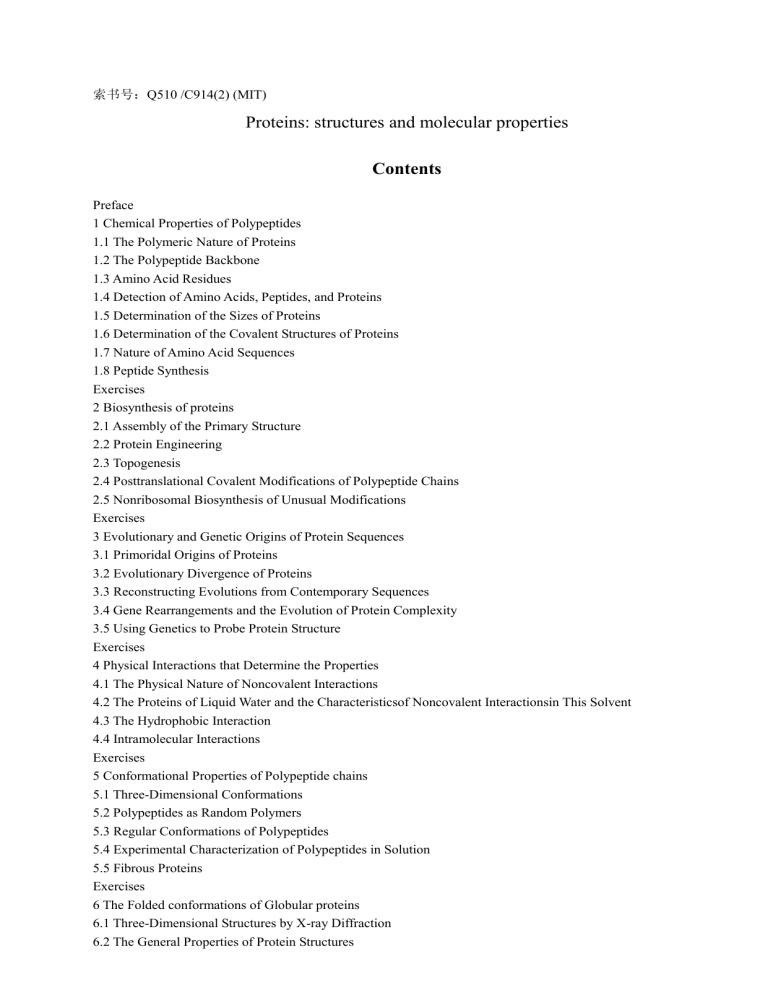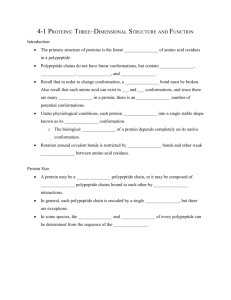索书号:Q510/c914(2) (MIT)

索书号: Q510 /C914(2) (MIT)
Proteins: structures and molecular properties
Contents
Preface
1 Chemical Properties of Polypeptides
1.1 The Polymeric Nature of Proteins
1.2 The Polypeptide Backbone
1.3 Amino Acid Residues
1.4 Detection of Amino Acids, Peptides, and Proteins
1.5 Determination of the Sizes of Proteins
1.6 Determination of the Covalent Structures of Proteins
1.7 Nature of Amino Acid Sequences
1.8 Peptide Synthesis
Exercises
2 Biosynthesis of proteins
2.1 Assembly of the Primary Structure
2.2 Protein Engineering
2.3 Topogenesis
2.4 Posttranslational Covalent Modifications of Polypeptide Chains
2.5 Nonribosomal Biosynthesis of Unusual Modifications
Exercises
3 Evolutionary and Genetic Origins of Protein Sequences
3.1 Primoridal Origins of Proteins
3.2 Evolutionary Divergence of Proteins
3.3 Reconstructing Evolutions from Contemporary Sequences
3.4 Gene Rearrangements and the Evolution of Protein Complexity
3.5 Using Genetics to Probe Protein Structure
Exercises
4 Physical Interactions that Determine the Properties
4.1 The Physical Nature of Noncovalent Interactions
4.2 The Proteins of Liquid Water and the Characteristicsof Noncovalent Interactionsin This Solvent
4.3 The Hydrophobic Interaction
4.4 Intramolecular Interactions
Exercises
5 Conformational Properties of Polypeptide chains
5.1 Three-Dimensional Conformations
5.2 Polypeptides as Random Polymers
5.3 Regular Conformations of Polypeptides
5.4 Experimental Characterization of Polypeptides in Solution
5.5 Fibrous Proteins
Exercises
6 The Folded conformations of Globular proteins
6.1 Three-Dimensional Structures by X-ray Diffraction
6.2 The General Properties of Protein Structures
6.3 Protein Structure Determination by Nuclear Magnetic Resonance Spectroscopy
6.4 Proteins with Similar Folded Conformations
6.5 Rationalization and Prediction of Protein Structure
Exercise
7 proteins in solution and in Membranes
7.1 Physical and chemical Properties of Soluble Proteins
7.2 Proteins in Membranes
7.3 Flexibility of Protein Structure
7.4 Stability of the Folded Conformation
7.5 Mechanism of Protein Folding
Exercises
8 Interactions with Other Molecules
8.1 Structures of Protein-Ligand Complexes
8.2 Energetics and Dynamics of Binding
8.3 Relationship between Protein Conformation and Binding
8.4 Allostery: Interactions between binding Sites
Exercises
9 Enzyme Catalysis
9.1 The Kinetics of Enzyme Action
9.2 Theories of Enzyme Catalysis
9.3 Examples of Enzyme
9.4 Regulation of Enzyme Activity
Exercise
10 Degradation
10.1 Chemical Aging
10.2 Protein Turnover in Vivo
10.3 Mechanisms of Protein
Exercises
Appendix 1 Major Protein and DNA Sequence Data Banks
Appendix 2 Reference to Protein Structures Determined Crystallographically to High Resolution
Index
Abstract
Because our understanding of protein structure and function has increased remarkably in the nine years since the first edition of this volume, most of this edition needed to be entirely rewritten. Many new posttranslational modifications of proteins have been found, a number of physiological importance, and those best characterized are described in Section 2.4.
An innovation in this edition is the exercises at the end of each chapter. They are intended as informative and instructive exercises by which students can expand their understanding of proteins and of how scientific research progresses, primarily by referring to the literature.








